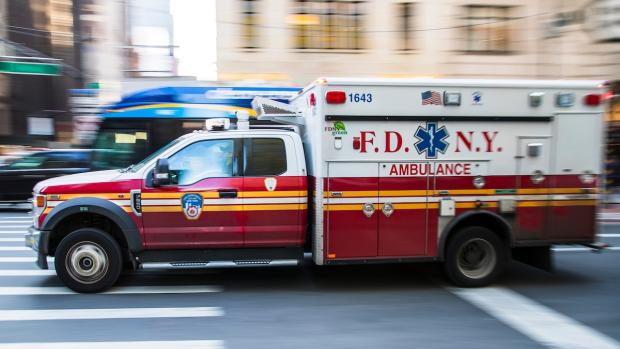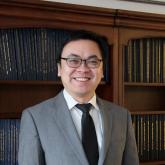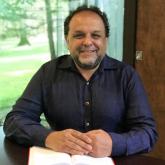A C2SMARTER way to reduce FDNY response time
NYU Tandon's Transportation Center partners with the New York City Fire Department to speed up emergency responses using AI technology

In a pioneering effort to help provide faster, more equitable life-saving emergency services in areas with high traffic congestion, researchers at NYU Tandon School of Engineering’s transportation center, C2SMARTER, are leveraging AI technology to analyze and improve emergency vehicle travel times in partnership with the New York City Fire Department (FDNY).
The year-long project, a first of its kind, involves the creation of a “Digital Twin,” a virtual model of neighborhood traffic patterns. This virtual environment will enable C2SMARTER and FDNY researchers to understand the root causes of emergency response delays and test potential solutions before attempting them on actual streets.
The simulation overcomes shortcomings of traditional methods for evaluating potential emergency-response improvements, such as infrastructure modifications, fleet enhancements, and alternative routing, that are costly and disruptive to do in the real world.
This innovative approach aims to reduce FDNY emergency vehicle response times to life-threatening medical emergencies, which have risen to 7 minutes 26 seconds in fiscal year 2023 from 6 minutes and 45 seconds over a ten-year period.
Led by Joseph Chow, Institute Associate Professor in the Department of Civil & Urban Engineering and associate director of C2SMARTER, the project builds upon Chow’s previous work on the MATSim-NYC traffic simulation developed in 2020.
The C2SMARTER team’s “Traffic Digital Twin” uses open-source traffic simulation software called Simulation of Urban Mobility (SUMO). The virtual environment will integrate real-time traffic data from cameras and sensors in the Harlem neighborhood, along with dispatch data from FDNY vehicles. Artificial intelligence will be used to mimic driver behavior and reactions to sirens and other signals from emergency vehicles.
“Communities like Harlem have been underserved in the past. They can see significant benefits from faster emergency vehicle responses,” said Chow, the project’s Principal Investigator (PI). “The project with FDNY is a prime example of C2SMARTER’s commitment to using New York City as a living laboratory to create engineering solutions that improve urban mobility and make life better for all New Yorkers.”
"Shorter response times are directly linked to better patient outcomes. It's critical we understand what impedes the fastest possible response and that we develop strategies to deal with those roadblocks," said Rebecca Mason, FDNY’s Assistant Commissioner, Management Analysis and Planning. "We contacted Professor Chow because of his groundbreaking work modeling New York City traffic. We hope this work serves as a template for other first responders in New York City and beyond."
The C2SMARTER team aims to make both the traffic simulation and accompanying AI tools freely available as open-source software. The team will also publish playbooks on optimal emergency vehicle strategies so other agencies can apply the lessons directly.
"If successful, this Digital Twin will be the first of its kind in the U.S., advancing the adoption of cutting-edge technologies for emergency response,” said Jingqin (Jannie) Gao, Assistant Director of Research at C2SMARTER. Gao, along with Professor Kaan Ozbay, Director of C2SMARTER, serves as a co-PI on the project. “This unique approach — incorporating real-world data, promises a refined AI training environment and a comprehensive understanding of urban reactions to Emergency Medical Vehicle interventions — is not available elsewhere in the U.S. The study aims to provide a scientific benchmark, guiding future research. It could encourage other emergency agencies, especially in congested urban areas, to adopt similar Digital Twins and interventions."
C2SMARTER, a Tier 1 University Transportation Center designated by the U.S. Department of Transportation, has a long track record of working with New York City agencies to improve the city’s traffic infrastructure and operations. It was instrumental in the testing and deployment of Weigh in Motion (WIM) devices to curtail overweight vehicles on the Brooklyn-Queens Expressway, through a first-in-the-nation automated enforcement program that went into effect in November 2023. It collaborated with the NYC Department of Transportation and U.S. DOT in the NYC Connected Vehicle Pilot Program.
A consortium of seven universities led by NYU Tandon, C2SMARTER is pursuing an ambitious research, education, training, and technology transfer program agenda to address the U.S. DOT priority area of Congestion Reduction. It received its most recent Tier 1 UTC designation in early 2023, providing it $15 million in funding for five years and extending its first such designation that came in 2016.
C2SMARTER’s project with FDNY started in October 2023 and is expected to conclude in September 2024.






